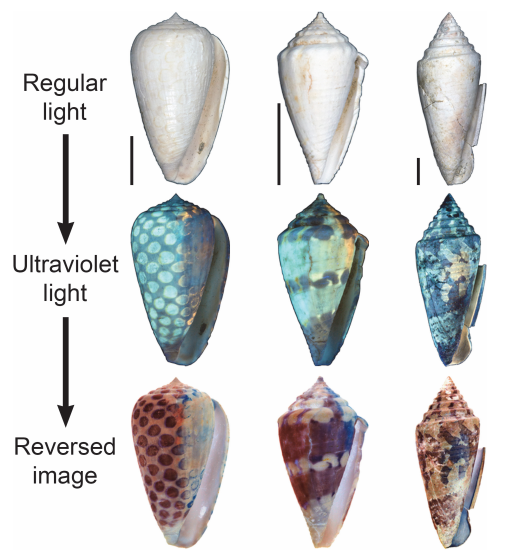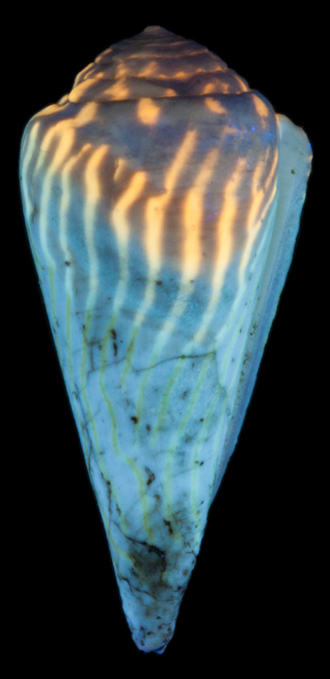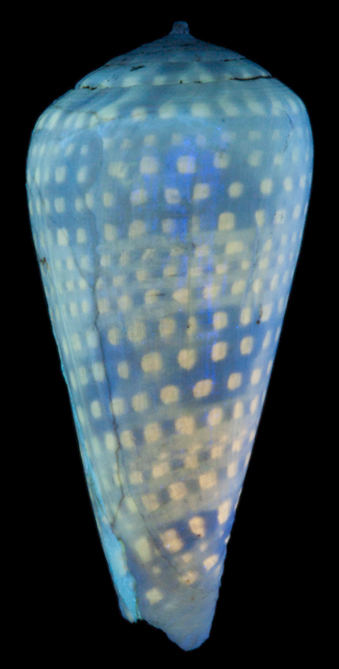Image: Jonathan Hendricks
Oftentimes, when you find a sweet-looking shell on the beach, it's white. But it probably wasn't always that way; over the course of, sometimes, millions of years, the color just fades. One researcher, however, is bringing those colors back. And in the course of doing so, he's discovered more than a dozen new species of sea snails.Jonathan Hendricks, a researcher at San Jose State University in California, discovered that, when placed under an ultraviolet light, it was possible to discern the long-faded patterns of cone snail shells that were up to 6.6 million years old. Then, using Photoshop, he was able to determine what the shells once looked like when the snails were alive. "The patterns of shell coloration are revealed under UV light, but not the ancient colors of the shells themselves. Regions that were pigmented [while the snails were alive] fluoresce as bright regions under UV light," Hendricks told me in an email. "These fluorescing, yellowish regions (associated with areas of pigmentation) would have been darkly colored when the animal was alive, however. So, I used Photoshop to create digital negative/inverse images of the photographs taken under UV light, thereby reconstructing what the shell would have looked like when the animal was alive."
"The patterns of shell coloration are revealed under UV light, but not the ancient colors of the shells themselves. Regions that were pigmented [while the snails were alive] fluoresce as bright regions under UV light," Hendricks told me in an email. "These fluorescing, yellowish regions (associated with areas of pigmentation) would have been darkly colored when the animal was alive, however. So, I used Photoshop to create digital negative/inverse images of the photographs taken under UV light, thereby reconstructing what the shell would have looked like when the animal was alive." This isn't all just to create some pretty pictures, of course. Hendricks analyzed 28 different species of cone shell, studying the patterns, shell shape, coloration, and other ornamental features. He was able to identify 13 new species, and says many of them have relatives that are still alive today. Hendricks published photographs of the shells and a description of the species in a paper published Wednesday in PLOS ONE.While it's certainly serious science, it wasn't overly difficult to imagine what the colors once looked like, once he had a method down.
This isn't all just to create some pretty pictures, of course. Hendricks analyzed 28 different species of cone shell, studying the patterns, shell shape, coloration, and other ornamental features. He was able to identify 13 new species, and says many of them have relatives that are still alive today. Hendricks published photographs of the shells and a description of the species in a paper published Wednesday in PLOS ONE.While it's certainly serious science, it wasn't overly difficult to imagine what the colors once looked like, once he had a method down. "In terms of the method itself, it was very simple: I just placed the shells under UV lamps in a darkroom and took photographs," Hendricks said. "In most cases, prior to photography, I bleached the shells in Clorox, as this enhances the fluorescence under UV. That was really the extent of the method."
"In terms of the method itself, it was very simple: I just placed the shells under UV lamps in a darkroom and took photographs," Hendricks said. "In most cases, prior to photography, I bleached the shells in Clorox, as this enhances the fluorescence under UV. That was really the extent of the method."
Advertisement



